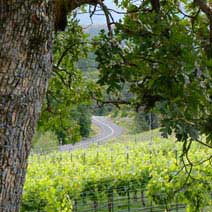 It’s October and people are starting to wonder what wine quality 2011 is going to produce. Frankly, I view reports on the 2011 grape crops status, called “vintage reports” about as useful as a few sentences attempting to describe the quality of food in Chicago!
It’s October and people are starting to wonder what wine quality 2011 is going to produce. Frankly, I view reports on the 2011 grape crops status, called “vintage reports” about as useful as a few sentences attempting to describe the quality of food in Chicago!
This vague uselessness is especially irrelevant here in Southern Oregon where we have broad and diverse micro-climates and grow a wide variety of grapes that respond differently to quirky weather patterns Mother Nature throws at us. There is a saying, “great winegrowers will grow great grapes even in the most challenging years.” And from great grapes, come great wines – the reverse is never true!
Still, people ask the question of what kind of year is 2011 going to be, so let me give a report from the field with my take on the challenges we growers will be facing this year.
Here at my Cricket Hill Vineyard and winery in the Applegate Valley, beginning late last year we began to be concerned. North Pacific currents indicated we might be in for another year like 2010 – and that year was what we would affectionately call a “tough” one. Still, farmers are eternally hopeful, so we crossed our fingers and waited. The winter rains didn’t come and didn’t come. Were we in for a drought year? Nope. They were just late, but then made up for their tardiness with longevity. Water, water everywhere. The groundwater was, shall we say, “replenished!” And then some.
The rains didn’t stop as we headed into April and May. And that’s when we began to get nervous. The grapes kept their heads down in response. They weren’t about to chance sticking their necks out with Mother Nature on the rampage as she was.
Unseasonably late, cool rains ran up to June when we finally got what looked like a break. The sun came out, buds began to swell and it looked like we were running just a couple of weeks late. But all that moisture put mildew pressure on the fields – so out came the sprayers. No sooner had those mildew preventing sprays hit the vines when along came another rain and washed them off. The same thing happened again in July. Only this time, it was worse – the plants had put out hundreds of little leafy shoots that were great mildew nurseries, allowing Mother Nature to throw us another curve ball.
Farmers all around the Rogue Valley were facing a dilemma: do we open up canopies by thinning leaves to lessen mildew pressure to extract as much sunlight or face exposing the grapes to sunburn from a heat spike? Welcome to the world of the wine grape farmer – a poor fellow who has to make a make-or-break bet even before the cards are dealt.
We haven’t gotten to this stage yet, but from similar conditions in 2010, the folks with a lot of vineyard management experience were able to harvest some good grapes. However, after the sunburned and otherwise damaged clusters were taken out, yields were generally lower than the more typical 2008 crop.
So is there any upside? Well, some have suggested that the fruit that got to the winemaker in 2010 was perfectly ripe and, in general, had gotten the opportunity to ripen more slowly – under less heat than usual.
Winemakers who can take advantage of what Mother Nature gives may be making some remarkable wines from the 2010 crop and perhaps again in 2011 – likely to be wines with lower alcohol levels and greater elegance and balance.
Of course, all the cards aren’t on the table yet. We’ll just have to see what magic evolves when the wines are ready for tasting in a couple of years. That’s just part of the ever-changing mystery and joy of wine making here in the Applegate Valley.
Duane Bowman is a Director of Applegate Valley Oregon Vintners Association and winemaker at Cricket Hill Winery located at the 2 mile marker on Little Applegate Rd. Find him at www.crickethillwinery.com or email duane@crickethillwinery.com

